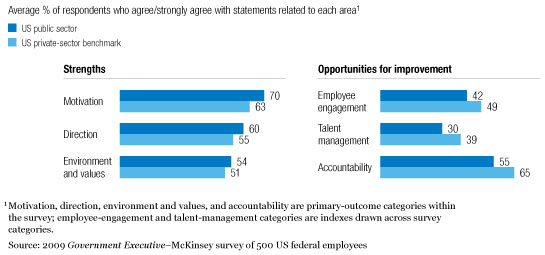The US federal government lags well behind the private sector in a number of important organizational-performance measures, particularly in fostering employee engagement, talent management, and accountability, a McKinsey survey finds. But the federal government enjoys relative strengths in the elements that deal with the heart of an organization. Government managers—more so than their private-sector counterparts, the survey found—understand and embrace the direction and vision of their organizations and are motivated to make a difference (exhibit).
Motivated but less accountable

McKinsey, in partnership with Government Executive magazine, recently surveyed more than 500 federal employees from dozens of agencies to provide input for government leaders seeking to strengthen performance. The survey measured the elements that contribute most to organizational performance and also compared the results to private-sector benchmarks.1 Among the elements measured were the following:
Direction: Are managers devoting adequate time to developing a vision and explaining it in terms that are relevant to employees?
Environment and values: Do people join and stay with their government agency because of the culture and values it fosters, and are the culture and values of the agency clearly defined?
Motivation: Are employees highly motivated and do they exert extraordinary effort when needed?
Engagement: Does management consult with employees on issues important to them, and are people within an agency encouraged to provide honest feedback to one another?
Talent management: Do managers provide helpful coaching, and are agencies continually refreshing their talent pool?
Accountability: Do employees know what they are held accountable for, and is there a direct link between performance and consequences?
The survey results suggested the following three areas of focus for the government:
Engage the federal workforce to gain their input, earn their commitment, and ensure an open and trusting environment. For example, only 29 percent of General Schedule (GS) 12–15 public-sector respondents agree or strongly agree that they are consulted on issues that affect them, compared with 43 percent of the Senior Executive Service (SES) sample and 40 percent in the private sector. Just 34 percent of GS 12–15 public-sector respondents agree or strongly agree that they operate in an open and trusting environment, compared with 50 percent of the SES sample and 49 percent in the private sector. And only 34 percent of GS 12–15 public-sector respondents suggest they are encouraged to provide honest feedback to people within the agencies, compared with 51 percent of the SES sample and 48 percent in the private sector.
Strengthen talent-management practices to attract, develop, and retain human capital. The survey results suggest there is an opportunity to improve coaching and feedback in government. Only 29 percent of public-sector respondents agree or strongly agree that managers provide helpful coaching to develop senior-management capabilities, compared with 41 percent in the private sector. Similarly, the results indicate an opportunity to improve capability building: 36 percent of public-sector respondents agree or strongly agree that their agency provides on-the-job assignments to develop the capabilities of their senior managers, compared with 41 percent in the private sector. There is also an opportunity to attract talent with the right skills and expertise through nontraditional channels. For example, only 22 percent of public-sector respondents believe their agencies recruit top talent from outside, either from other areas of government or the private sector, compared with 32 percent in the private sector.
Improve accountability measures by introducing more rigorous operating metrics and performance-management systems and by clarifying roles and objectives. Only 40 percent of public-sector respondents agree or strongly agree that the government has a robust performance-management system, compared with 64 percent in the private sector. Just 38 percent agree or strongly agree that their agencies hold challenging reviews to evaluate performance against plans, compared with 56 percent in the private sector. And only 55 percent agree or strongly agree that they have clear explanations of what has to be achieved in their jobs, compared with 68 percent in the private sector.
Government leaders have an important opportunity to improve the performance of their organizations by harnessing the passion and motivation of the federal workforce. As leaders shape their performance agenda, we encourage them to prioritize management practices that help them engage the workforce more fully, strengthen talent management, and improve accountability.


